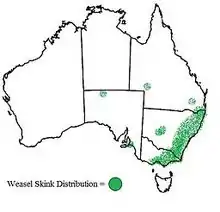| Saproscincus mustelinus | |
|---|---|
_(26252273921).jpg.webp) | |
| Scientific classification | |
| Domain: | Eukaryota |
| Kingdom: | Animalia |
| Phylum: | Chordata |
| Class: | Reptilia |
| Order: | Squamata |
| Family: | Scincidae |
| Genus: | Saproscincus |
| Species: | S. mustelinus |
| Binomial name | |
| Saproscincus mustelinus (O'Shaghnessy, 1874) | |
| Synonyms | |
| |
Saproscincus mustelinus,[3] commonly known as the southern weasel skink or weasel shadeskink, is a small species of skink which is endemic to Australia.
Behavior
S. mustelinus is usually nocturnal, but is most active in the evening and warm mornings.
Diet
S. mustelinus hunts and feeds on small insects and other small invertebrates.
Description
The southern weasel skink is around 45 mm (1.8 in) from snout to vent, is covered in iridescent reddish brown (fine) scales, and has several distinctive white marks behind and below the eye.[4]
Defensive behavior
If frightened this skink has the ability to lose its tail as a defence mechanism; the tail lies on the ground twitching, distracting the predator so the skink can escape.[5][6][7]
Habitat

The southern weasel skink tends to utilize existing vegetation and fallen timber for shelter.
Geographic range
The southern weasel skink's distribution forms a coastal strip from south Victoria to southern Queensland.[4][9]
Reproduction
Females lay up to four eggs per clutch in a communal nest. The nests are normally a dugout, a burrow, which contain the eggs of numerous females.[10] Laying normally occurs between spring and late summer.
References
- ↑ Shea, G.; Hutchinson, M.; Chapple, D. (2018). "Saproscincus mustelinus". IUCN Red List of Threatened Species. 2018: e.T109481266A109481279. doi:10.2305/IUCN.UK.2018-1.RLTS.T109481266A109481279.en. Retrieved 19 November 2021.
- ↑ "Saproscincus mustelinus ". The Reptile Database. www.reptile-database.org.
- ↑ "Home - Inner West Council".
- 1 2 "Weasel Skink". museumvictoria.com.au. Archived from the original on 3 August 2008. Retrieved 22 May 2022.
- ↑ AusEmade, Team. "Fauna: Weasel Skink Images - (Saproscincus mustelinus)". www.ausemade.com.au.
- ↑ Wilson, Denis (18 June 2010). "The Nature of Robertson: New Skink for my list".
- ↑ "Archived copy" (PDF). Archived from the original (PDF) on 2015-09-23. Retrieved 2014-06-14.
{{cite web}}: CS1 maint: archived copy as title (link) - ↑ Australia, Atlas of Living. "Saproscincus mustelinus : Weasel Skink - Atlas of Living Australia". bie.ala.org.au.
- ↑ "Weasel skink (Saproscincus mustelinus) at the Australian Reptile Online Database - AROD.com.au". www.arod.com.au.
- ↑ AusEmade, Team. "Fauna: Weasel Skink (Saproscincus mustelinus) - Reptile". www.ausemade.com.au.
Further reading
- Boulenger GA (1887). Catalogue of the Lizards in the British Museum (Natural History). Second Edition. Volume III. ... Scincidæ ... London: Trustees of the British Museum (Natural History). (Taylor and Francis, printers). xii + 575 pp. + Plates I-XL. (Lygosoma mustelinum, p. 267 + Plate XIX, figures 2, 2a).
- O'Shaughnessy AWE (1874). "Descriptions of new Species of Scincidæ in the Collection of the British Museum". Ann. Mag. Nat. Hist., Fourth Series 13: 298–301. (Mocoa mustelina, new species, p. 299).
External links
![]() Media related to Saproscincus mustelinus at Wikimedia Commons
Media related to Saproscincus mustelinus at Wikimedia Commons
